
The Future of Social Commerce: Your Guide to Success in the $6 Trillion Market
SHARE :



A group of Australian business researchers published an interesting article about social commerce last year on Elsevier Inc.
They accurately measured the social commerce market size to be $727.6 billion in 2022, with an annual growth rate of 30.8%. We did a quick calculation—we’re looking at a $6 trillion market by 2030.
That’s both thrilling and a bit scary for business owners. Massive opportunities are opening up, but so are the risks of missing out completely.
As a business owner, you have to understand social commerce inside and out to ride these waves of change successfully. And that’s exactly what we’re here to help you with.
In this article, we’ll explore the future of social commerce, cover the emerging trends, and show you how brands are already preparing for what’s coming next.
Let’s get started.
What is social commerce?
In simple terms, social commerce means browsing and shopping directly from social media platforms like Facebook, Instagram, YouTube, X, or TikTok.
Also known as social e-commerce or social retailing, it involves discovering products or brands through posts, short videos like Reels, stories, or user-generated content, as well as influencer recommendations.
History of social commerce
It may be a little hard to believe, but Yahoo introduced the term “Social Commerce” first. In 2005, Yahoo launched pick lists (basically a shared wishlist of products), content tagging, and user ratings. Yahoo realized that users will always trust the experience of previous customers rather than the brand.
Fast-forward to 2025, and the social commerce market is now solely related to selling via social platforms. The social commerce industry has evolved dramatically, with every major social channel on this planet providing many business features, making it our cosy and favorite marketplace.

What is the present situation of social commerce?
A half-hour TikTok live is engaging millions of viewers.
A properly set-up Instagram Shop is bringing hundreds of viewers to a business account.
Snapchat’s AR filter is enabling users to virtually “try on” new makeup and share pictures with friends.
How do they sound? Easy? Convenient? Fun?
If your answer is yes, welcome to the wonderful world of social media commerce.
In 2025, social commerce’s influence is stronger than ever, and it will undoubtedly continue to grow as part of broader social media e-commerce trends.
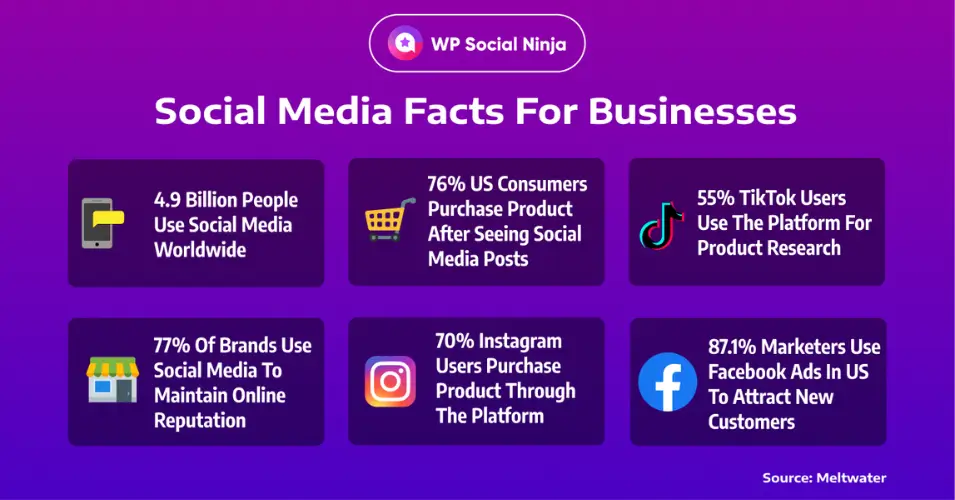
According to the Meltwater report, 90% of brands use social media to build a strong awareness, and 39% of customers trust a brand only when they can interact with it on social media platforms.
These social commerce statistics highlight the growing importance of social platforms in modern retail strategies.
Social media is no longer a platform for connecting with friends; it has become an ecosystem of its own.
When social shoppers can merge the engaging and interactive nature of social channels with their business, the door to reach the largest audience opens for them.
Social commerce is already one of the most rapidly growing markets in the US, with $79.6 billion in sales in 2025.
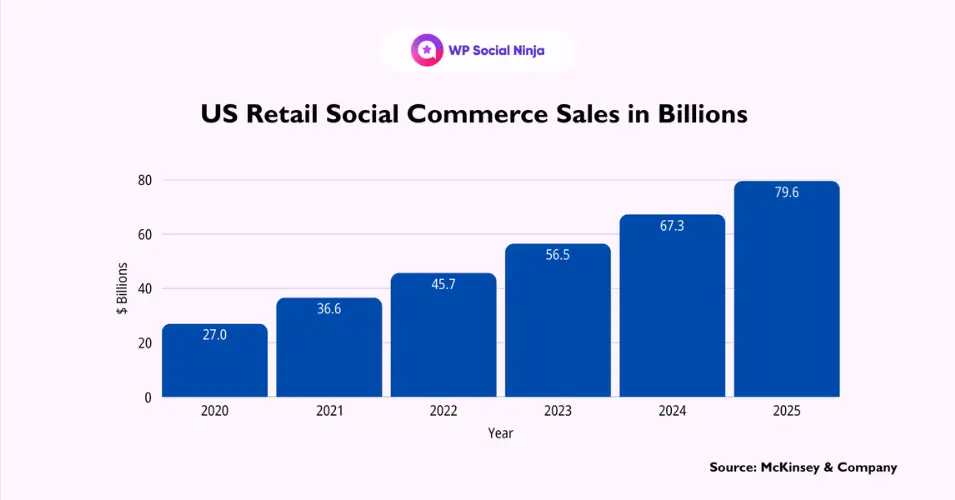
Think of this scenario– a user scrolling through Instagram and finds pet care products you’re selling with a Shop Now button. He clicks it without leaving the platform, confirms the order, and you are ready to ship. Doesn’t that sound like everybody wins?
Pro Tips: Learn about the smartest and most effective way to set social media marketing goals for maximum profit for your business.
What is the difference between social commerce and e-commerce?
Understanding social commerce vs e-commerce is crucial for modern businesses. Although social commerce is technically a branch of e-commerce, they are not exactly the same.
E-commerce includes all forms of shopping that take place online, mostly through brand websites and online marketplaces like Amazon, AliExpress, or Temu. Traditional e-commerce social media integration typically involves promoting products on social platforms and driving traffic to external websites.
On the other hand, social commerce involves selling directly from social platforms like Facebook, Instagram, or TikTok.
A social commerce business does not require a website or app. It usually promotes and generates sales using the native tools provided by the platforms, representing a shift toward social retail models.
While e-commerce marketing mainly focuses on SEO and website optimization, referrals, and advanced user experience, social commerce growth primarily depends on social media marketing strategies. You’ll also need a clear idea about the latest social commerce technology.
Special Note: Social retailers can always benefit more from maintaining a website with an online store by driving traffic from both social channels and Google searches. Learn how to create a business website for free to get started and experience greater benefits and more revenue.
The future trends in social commerce
Social commerce is all about going with the flow.
What makes social commerce truly different from typical online businesses is its ability to blend with new trends in social media and make our shopping experience exciting and fun. That’s why understanding social shopping trends and current social trends is essential for success in this dynamic market.
In this section, we will discuss the latest trends in social media and share proven social commerce strategies for your success.
So, grab your coffee and let’s start your journey to growth right now.
1. Leverage different social communities
Social media users now prefer quality engagement over reach. They form different social communities like Facebook Groups, X Communities, Subreddits, or Quora Space to connect with other people with similar interests and discuss things they like.
Members of the communities share a strong bond with each other and trust the opinion of their peers.
These places reflect the current trends in social media and are gold mines for businesses to learn about the pain points, needs, and preferences of their potential customers.
That’s why building your influence in different communities where your target audience hangs out should be on the list of your social commerce marketing in 2025.
Here are some pro tips to leverage different social communities for social selling:
- Join multiple communities where your target audience belongs. Understand the rules and regulations before joining and follow them strictly when posting.
- Do not bombard your audience with your sales pitch from the start. First, take your time to understand your audience. Then, join different discussions, provide helpful insights, and gradually build your authority.
- When you start posting about your products or services, focus more on how your business can solve the problems of the members. Be consistent with your posts and responsive towards any kind of feedback.
- Always avoid any controversies. You are here to promote your business, not to win arguments. If you feel attacked by other members, approach them with a calm attitude and empathy.
Case study: Elementor
Elementor is a popular WordPress website builder platform. It has a huge Facebook group named Global Elementor Community with 153k+ members where users share their latest projects, discuss different technical issues, and help new users.
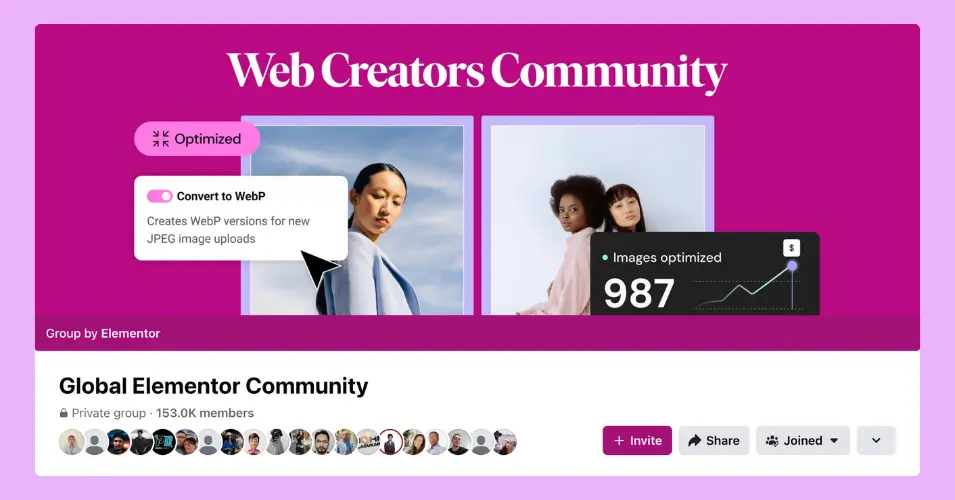
The brand is an ideal example of how the community can help a business thrive and how your existing customers can become the biggest advocates for new users.
2. Invest in live and short-form videos
Video marketing is and will continue to be one of the most formidable digital commerce trends, as well as the most dominant form of content in 2025.
According to Meltwater data, 80% of companies reported that videos performed better for them than any other format of content.
Let’s start with short-form videos, the most trendy video marketing tool in the social commerce market. We all know the addictive nature of Instagram Reels, TikTok videos, or YouTube Shorts. They are easy to digest, fun to watch, and let businesses present their products as creatively as possible.
On the other hand, live streaming is one of the most crucial social media Ecommerce trends to create awareness and showcase the authenticity of your products.
Facilities like instant comments and responses, polls, reactions, filters, and effects that let businesses engage viewers in real-time and start a long-term relationship. Businesses cannot afford to ignore such a key trend on social media.
Here are some pro tips to use videos for your maximum social commerce growth:
- Short videos are all about being creative and trendy. Observe the latest trends in memes, music, and editing styles and implement them in your videos. You can even use tools like Spark AR (Instagram) or Effect House (TikTok) to gamify your content.
- Add polls, quizzes, or clickable links to make your videos more engaging and personalized. Always optimize captions with relevant keywords and trending hashtags to improve discoverability.
- For live streaming, check your light setup and internet connection beforehand. Avoid direct sales pitching during your broadcast and respond to comments from time to time to keep your viewers engaged and connected.
- Consistency is the cornerstone of success for video marketing. For short-videos, try to upload at least 4 or 5 times in a week and for livestreaming you should maintain a strict routine for your sessions.
Case study: Popflex
From making YouTube Shorts about fitness to one of the most trendy women’s clothing brands in the US, Popflex has truly shown the power of short-format videos. Since its launch in 2016, Popflex has focused its marketing based short-format videos. Now, their business has been featured in the Inc. 5000 list and has seen a staggering 800% growth in revenue by 2019.
3. Take advantage of AR and VR
Augmented reality (AR) and Virtual Reality (VR) are the latest additions in social commerce technology, and they are about to reshape and revolutionize the social media experience soon.
As a business owner, you must adopt AR and VR for your future social commerce strategy.
Instagram and Snapchat have already introduced AR filters to let users virtually try on products like makeup, clothes, or jewelry. They allow users to understand how a product will look on them and help them make purchase decisions fast.
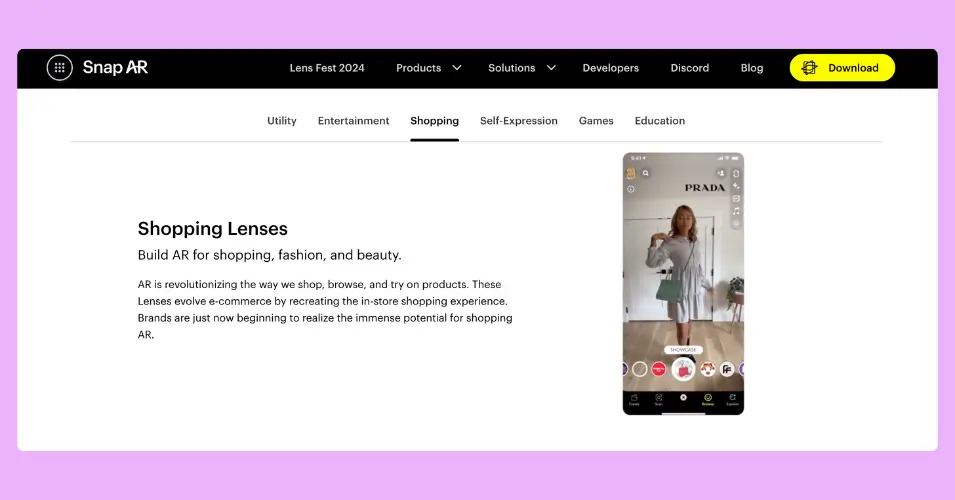
Meanwhile, Facebook is experimenting with VR through Horizon Worlds, where businesses can host virtual events or create immersive brand experiences. TikTok is also experimenting with AR effects, allowing brands to craft viral, interactive content with ease.
Here are some pro tips for you to take advantage of AR and VR:
- Use the AR filter features of Meta and Snap AR of Snapchat to create customized filters so that the viewers can access virtual try-ons for makeup or skincare products or visualize how furniture or decor would look in their homes.
- Experiment with creating AR games and challenges with the Effect House of TikTok and using trending soundtracks and hashtags. You can also explore hosting virtual events and stores using the Metaverse if it is available in your region.
Case study: IKEA
The Swedish furniture giant IKEA helps customers visualize how furniture would look in their home using AR. They have a 3D catalogue of 3,000 furniture. When a potential customer selects their products, the filters adjust them to the dimensions of the room and place them virtually in the room to provide a pre-experience.
4. Use different AI tools smartly
Considering how AI has been influencing workflows across different industries, businesses should no longer ignore its impact on their social commerce strategy.
According to the Semrush report, 79% of businesses have improved their content quality using AI, making it one of the most important new social trends.
Many social media platforms are now developing their own AI tools. Take Meta AI or Grok as examples. X users can now access these tools directly from their feed, eliminating the need to switch to another app or device. So, generating new content ideas or finding answers to questions has become much more convenient and easier.
Here are some pro tips to use AI smartly for your social commerce business:
- You can use AI tools like Persado or Copy.ai to generate high-quality social media post captions and ads.
- Tools like Google Trends AI, Crayon, or TrendKite can help you understand upcoming trends and develop new content strategies for maximum reach.
- Use Meta AI and Grok to generate interactive images, GIFs, and short videos faster. However, make sure that your content matches your brand voice and describes your products or businesses clearly.
Case Study: Day 1 Company
Day 1 Company is a Korean educational service business that identifies shifts in the job market and launches courses accordingly for employees to stay up-to-date. They earned $70 million in revenue for two years straight by targeting audiences precisely based on their activities using Meta AI to automate their marketing campaigns.
5. Provide chat support with messaging apps
Selling online means facing lots of questions from your customers. Especially in social commerce, customers are often quite skeptical and require a fast response. That’s exactly where messaging apps can help you to keep up with social media shopping demands.
Chat covers the biggest lacking of online business, the human touch. When customers feel more understood through clear communication, they are likely to purchase from you and return in future.
Here are some pro tips to use messaging apps for better customer satisfaction:
- Create different chat groups, like WhatsApp Community or Telegram Channel, and encourage your customers to join them. Use these groups to announce product updates and discounts.
- Hold various discussion sessions regarding your products or services to understand how customers actually feel about your business. Use this feedback to improve your business strategy and product quality.
- If any of your group members express dissatisfaction, do not hesitate to reach out to them personally. Try to understand their problems with an open mind and be empathetic while responding to any issues.
- You can use automated chatbots for your WhatsApp, Telegram, or Messenger. It’s not always possible for you to attend to all queries at once. But chatbots can handle basic tasks like welcoming messages, answering frequently asked queries, or order confirmation..
Case study: Adidas
Adidas has been using WhatsApp since 2015 to answer questions about its products and promote new items. In 2019, it launched a unique campaign using WhatsApp groups, where recreational teams can hire a professional athlete for friendly matches. The athlete comes to the matches wearing Adidas products. This campaign helped Adidas creatively promote new products and generate more sales.
6. Collaborate more with micro-influencers
Once, brand endorsement from mega-celebrities worked wonders for brands, but the tides have been shifting for quite some time. People now, especially the Gen Z audience, prefer micro or niche-based influencers more, representing a significant social trend in modern marketing.
74% of Gen Z shoppers rely on micro-influencers for brand discovery and making their purchase decisions. The reason is actually pretty simple. Micro-influencers feel more relatable, and they understand the pulse of the young audience better.
Here are some pro tips for better collaboration with micro-influencers:
- Prepare a list of popular influencers in your niche. Watch their content quality and how well they represent their previous brands. Then, reach out to the influencers who suit your brand voice better.
- Be vocal about your demands and understand their charges clearly. Prepare a list of products you want them to promote. Send free samples to them so that they have the opportunity to test them before making content.
- Ask your selected influencer to show you the content before publishing and check for any misinformation. Make sure that your influencer is using proper referral links with trackers so that you can measure the impact of your collaboration.
Case study: Canon
To target the younger audience, the camera brand Canon occasionally launches micro-influencer collaborative programs. Here, influencers make TikTok videos about Canon products, and in return, they are compensated and earn free products. This way, Canon forms a stronger bond with the new generation and gets promotional content from influencers.
7. Integrate social commerce business with your Ecommerce website
Two is better than one! Social commerce is gaining more traction every day, and there is no doubt about that. However, when you integrate social commerce with your e-commerce, it can open the door to limitless opportunities and maximize the benefits of social commerce.
For example, social media feeds on any website provide visitors with a quick overview of how well the business is maintaining its social presence on different platforms. Visitors can visit your social profiles directly from your website, eventually leading to more followers.
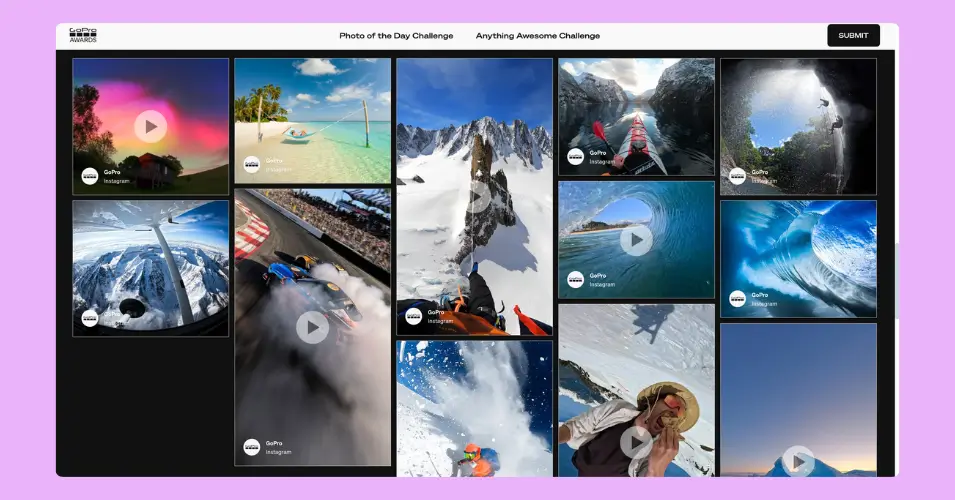
Another great example is adding Facebook reviews to your website. Facebook holds 19% of the world’s total online reviews. So, showcasing your Facebook reviews on your website immediately earns the trust of your customers and leads to a higher conversion rate.
Social media channels are crowded, and it’s quite hard to stand out. Meanwhile, it is comparatively easier to integrate social channels on your website and rank high in search results with proper SEO optimization.
On the technical side, using social media plugins for integration saves you a lot of server space. When your site doesn’t get bloated with the pressure of content, it naturally loads faster, leading to a better user experience.
That’s how social commerce and Ecomemrce together can provide a greater benefit for your business.
Here are some pro tips for integrating social commerce on your Ecommerce website:
- Use tools like WP Social Ninja to integrate customized social media feeds, customer reviews, and chat widgets on your WordPress website.
- Enable the auto-update feature for your embedded platforms so that new content gets uploaded automatically, saving you from extra hassle. Moreover, fresh content keeps your website healthy and improves SEO.
- Make sure to enable the follow button on the integrated social feeds so that visitors can easily find your social channels.
Case study: GoPro
GoPro has a dedicated website page where they showcase their Instagram feed videos made by users. This initiative helps new visitors understand their product better. Moreover, user-generated content inspires new users to use GoPro cameras more creatively and motivates them to create more content.

The best social commerce platforms
There’s no one-size-fits-all in the social commerce business. Each platform has its own strengths, and success depends on choosing the right ones based on where your audience spends time. That’s why identifying the best social commerce platforms is essential.
It’s also smart to build a presence across multiple social media e-commerce platforms to ensure better reach and engagement.
In this section, we’ll highlight the key platforms in the global social commerce industry using insights from DataReportal.
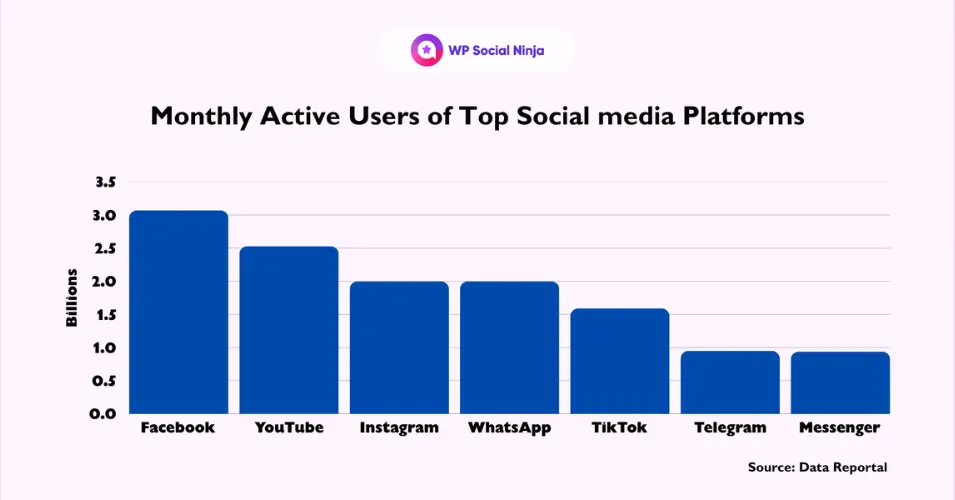
Facebook has more than three billion monthly users. Despite its drop in organic reach, Facebook still has the largest global social media audience and is a good place for businesses to get started with commerce social strategies.
On the other hand, Instagram is becoming increasingly popular among businesses and users. Its natural aesthetic ambience and business features make it an ideal choice for brands to promote their products. Almost 63% of Instagram users use this platform for brand research before making their purchase decisions.
YouTube, the largest video-sharing platform on this planet, will remain a goliath in the future of social commerce. Not only its user base is the most active user base, it has the largest ad audience in the world.
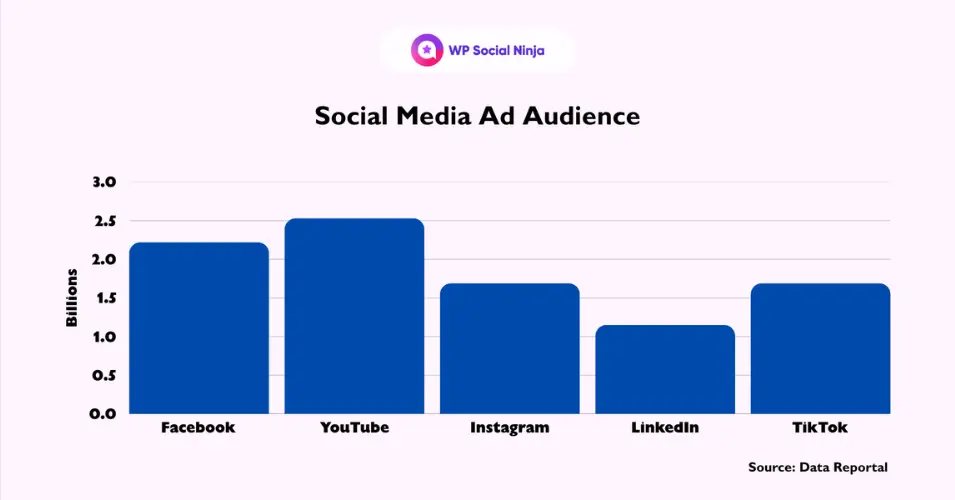
TikTok is the most surprising player in the social commerce market. From TikTok Shop to its academy facilities for educating small and medium businesses, the platform is going to be the next marketing behemoth.
Its Spotlight feature to promote TV shows and movies, affiliate features on in-app purchases, and, most importantly, its rising popularity among Gen Z have made this platform an excellent place for marketers and brands alike.
Pinterest and Reddit have become mainstream over the last few years, especially since Google started prioritizing Reddit on SERP rankings from its core update in November 2023. They will play a pivotal role in the future of social commerce for customer research.
Bonus Tips: Follow our detailed social media marketing guidelines to double your engagement and create a stronger brand presence.
Embrace the future
The future of social commerce is exciting and holds the power to reshape our shopping experience for good. But at the same time, the social trends in business are always changing.
Keeping an eye on key social commerce stats will help businesses stay informed and ready for what’s next. Businesses will require continuous learning and high adaptability for maximum social commerce benefits.
But you don’t need to worry about that. In this article, we have covered everything about social commerce best practices and equipped you with the latest trends in social media to stay ahead.
All you need to do is stay dedicated to your business and focus on quality. We genuinely hope our article will serve as your guidebook for future success. Till then, cheers!
Mashfik Upal Aumy
Aumy is a veteran Digital Marketer at WP Social Ninja, specializing in the WordPress industry. With almost two years of experience, Aumy crafts content that breaks down complex branding theories, product marketing campaigns, and social media tactics in a digestible manner for businesses. While not working, you’ll find him reading books, watching movies, or exploring new places on a bike.

Subscribe To Get
Weekly Email Newsletter
Connect, Customize, and Display Social Feeds, Reviews, and Chat widgets















Leave a Reply